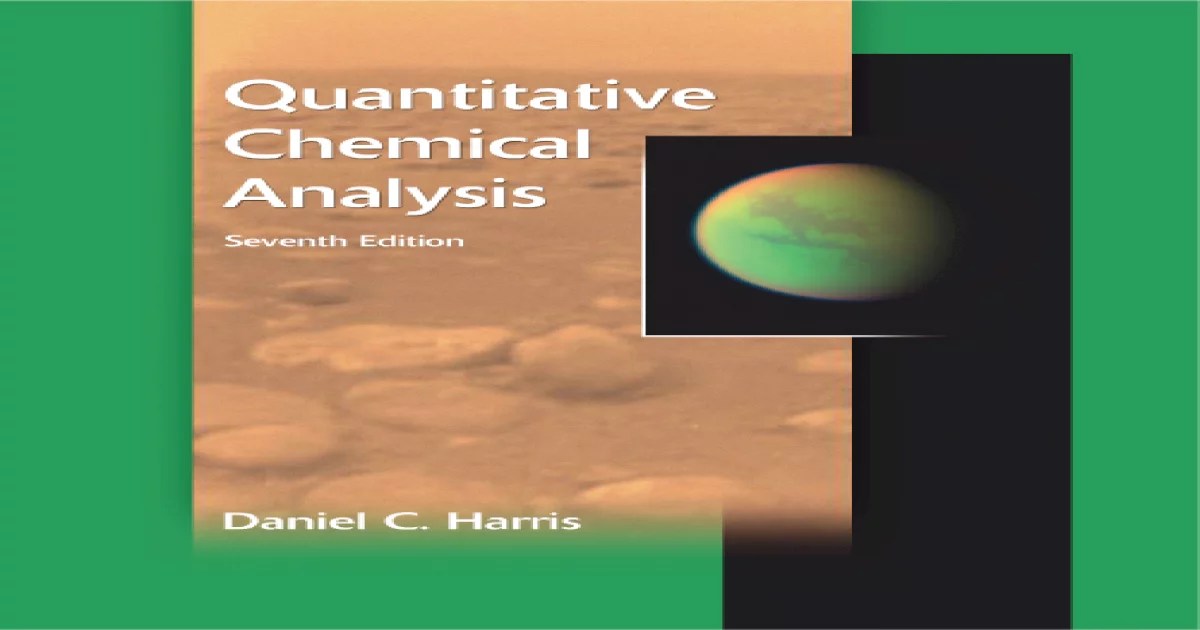Daniel c. harris quantitative chemical analysis 10th edition – Daniel C. Harris’s Quantitative Chemical Analysis, 10th Edition, is an authoritative and comprehensive textbook that provides a thorough exploration of the principles and applications of quantitative chemical analysis. This seminal work has shaped the field for decades, and its latest edition continues to set the standard for excellence.
With its in-depth coverage of fundamental concepts, cutting-edge techniques, and real-world applications, this book is an essential resource for students, researchers, and practitioners alike. It offers a comprehensive understanding of the theory and practice of quantitative chemical analysis, empowering readers to make informed decisions and solve complex analytical problems.
Daniel C. Harris Quantitative Chemical Analysis 10th Edition Overview
Daniel C. Harris’s Quantitative Chemical Analysis, 10th Edition, is a comprehensive and widely-respected textbook for students and professionals in the field of analytical chemistry. This edition builds upon the legacy of previous editions, offering a modern and up-to-date treatment of the fundamental principles and applications of quantitative chemical analysis.
The book’s key features include:
- A focus on real-world applications of quantitative chemical analysis, with examples drawn from a wide range of fields, including environmental science, food chemistry, pharmaceutical analysis, and forensic science.
- A thorough and up-to-date coverage of modern analytical techniques, including spectrophotometry, chromatography, electrochemistry, titration, and gravimetric analysis.
- A strong emphasis on data analysis and quality control, providing students with the tools they need to interpret and evaluate analytical data.
- A wealth of learning aids, including worked examples, practice problems, case studies, and online resources.
Quantitative Chemical Analysis, 10th Edition, is an essential resource for students and professionals in analytical chemistry. It provides a comprehensive and up-to-date treatment of the fundamental principles and applications of the field, and is a valuable resource for anyone who wants to understand the role of quantitative chemical analysis in modern society.
Key Concepts and Theories

The following are some of the key concepts and theories covered in Daniel C. Harris’s Quantitative Chemical Analysis, 10th Edition:
- Spectrophotometry: The study of the interaction of light with matter, and its application to the quantitative analysis of substances.
- Chromatography: The separation of mixtures of substances based on their different physical and chemical properties.
- Electrochemistry: The study of the relationship between electrical energy and chemical change, and its application to the quantitative analysis of substances.
- Titration: A technique for determining the concentration of a solution by adding a known amount of a reagent to it until a reaction is complete.
- Gravimetric analysis: A technique for determining the concentration of a solution by measuring the mass of the precipitate that forms when the solution is reacted with a reagent.
Analytical Techniques and Methods

Daniel C. Harris’s Quantitative Chemical Analysis, 10th Edition, describes a wide range of analytical techniques and methods, including:
- Sample preparation: The process of preparing a sample for analysis, including techniques such as filtration, extraction, and digestion.
- Data analysis: The process of interpreting and evaluating analytical data, including techniques such as statistical analysis and regression analysis.
- Quality control: The process of ensuring the accuracy and precision of analytical data, including techniques such as calibration and standardization.
- Troubleshooting: The process of identifying and correcting errors in analytical procedures.
Applications in Various Fields: Daniel C. Harris Quantitative Chemical Analysis 10th Edition

Quantitative chemical analysis is used in a wide range of fields, including:
- Environmental science: To monitor the levels of pollutants in the environment and to assess the impact of human activities on the environment.
- Food chemistry: To ensure the safety and quality of food products, and to develop new food products.
- Pharmaceutical analysis: To develop and test new drugs, and to ensure the safety and efficacy of drugs.
- Forensic science: To identify and analyze evidence in criminal investigations.
Pedagogical Features
Daniel C. Harris’s Quantitative Chemical Analysis, 10th Edition, includes a number of pedagogical features to help students learn the material, including:
- Learning objectives: Each chapter begins with a list of learning objectives that students should be able to achieve by the end of the chapter.
- Worked examples: Worked examples are provided throughout the book to illustrate the concepts and techniques discussed in the text.
- Practice problems: Practice problems are provided at the end of each chapter to help students test their understanding of the material.
- Case studies: Case studies are provided throughout the book to show how quantitative chemical analysis is used in real-world applications.
General Inquiries
What are the key features of the 10th edition of Daniel C. Harris’s Quantitative Chemical Analysis?
The 10th edition of Daniel C. Harris’s Quantitative Chemical Analysis offers several key features, including updated content reflecting the latest advancements in the field, expanded coverage of emerging analytical techniques, and a wealth of new practice problems and case studies.
How does this book compare to other leading textbooks in the field?
Daniel C. Harris’s Quantitative Chemical Analysis stands out as a comprehensive and authoritative textbook, providing a deeper level of coverage compared to other leading texts. It offers a more thorough examination of fundamental principles, a wider range of analytical techniques, and a greater emphasis on real-world applications.
What are the pedagogical features that make this book effective for learning?
The book employs a variety of pedagogical features to enhance learning, including clear and concise explanations, abundant worked examples, thought-provoking practice problems, and engaging case studies. These features help students grasp complex concepts, develop problem-solving skills, and apply their knowledge to practical scenarios.